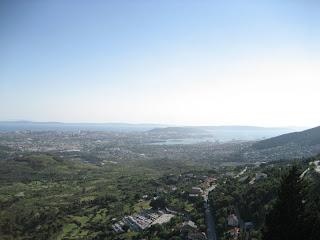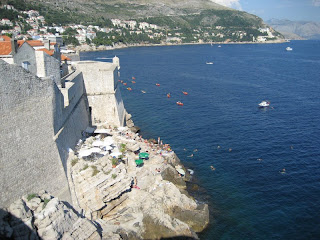
Here is what Croatia ACTUALLY looks like:





Croatia is a historically disputed region, once ruled by the Romans, Venetians, Ottomans, Austrians, French, and later collectively as Yugoslavia. Her stunning landscapes plentiful resources have made her one of the most fought-over regions on Earth.
My first stop was Pula, on the tip of the Istria peninsula, just a quick jaunt by sea across the Adriatic from Venice, Italy.

Formerly ruled by Rome, Pula is home to the 6th largest Roman amphiteater in the world, and one of the best preserved.


Home to many games and festivals, the arena was used to stage death-matches between Gladiators and captured exotic animals, hand-to-hand combat between men or women, and standard-issue executions of early Christians.
These are my feet, standing on the ground of ancient Rome.

I liked to imagine this nail had something to do with Jesus. I'm sure it didn't, but I don't really mind...

These are ancient pottery vessels, made to be propped into stands, and used to hold water, oil, or wine. If you look closely, you might see the name of its maker, stamped into the clay nearly two thousand years ago.

This is what they look like when stacked on their sides...

(hee! hee! hee! hee! hee! hee! hee! hee! hee! hee! hee! hee! hee! hee! hee! hee! hee! hee! hee! hee! hee! hee! hee! hee! hee! hee! hee! hee! hee! hee! hee! hee! hee! hee! hee! hee! hee! hee! hee! hee! hee! hee! hee! hee! hee! hee! hee! hee! hee! hee! hee! hee! hee! hee! hee! hee! hee! hee! hee! hee! hee! hee! hee! hee! hee! hee! hee! hee! hee! hee! hee! hee! hee! hee! hee! hee! hee! hee! hee! hee! hee! hee! hee! hee! hee! hee! hee! hee! hee! hee! hee! hee! hee! hee! hee! hee! hee! hee! hee! hee! hee! hee! hee! hee! hee! hee! hee! hee! hee! hee! hee! hee! hee! hee! hee! hee! hee! hee! hee! hee! hee! hee! hee! hee! hee! hee! hee! hee! hee! hee! hee! hee! hee! hee! hee! hee! hee! hee! hee! hee! hee! hee! hee! hee! hee! hee! hee! hee! hee! hee! hee! hee! hee! hee! hee! hee! hee! hee! hee! hee! hee! hee! hee! hee!)
Pula's (and much of Croatia's) architecture is a mix of Italian, Austrian, and French influences. Here is the Arch of the Sergii and a statue of James Joyce, who taught English at the nearby Berlitz School.


This is the Temple of Augustus. Construction began in 2BC and ended in 14AD.


Tiny streets make for tiny cars and motorcycles.


But you learn to look past that and see some of the benefits. Which are that you can drink beer--

-while driving.

Interestingly, every gas station has a coffee barista, and you can sit and drink a latte while reading the paper.

Or get a shot of something a bit harder. (Not a joke.)

Kristijan (pronounced: "Christian") took me to the beach near his hometown of Pula, and showed me the lunar landscapes that jut into the sea. Cliff faces and rock mountains are common in Croatia, and make for beautiful visual (and tactile) contrasts.

This is the last thing you see before jumping into the water.

Our road trip took us south to the Krka (Krka! Krka!) National Park, where we hiked a short distance across bridge-covered streams until we reached the Skradinsi Buk-- waterfalls.


That people (including us!) want to be in.

(not pictured: us.)
Here is some beautiful Croatian florae:



This was all in the front yard of this private residence we stayed at one night, one of many that dotted the coastline as we drove south from Zadar to Split.

Split is a stunning Venetian relic, and we arrived in time for a great dinner and a moonlight stroll around the city center, which was hosting an outdoor opera performance near the bell tower. (Hearing is free!)

This is me touching the toe of Grgur Ninksi, the 10th century bishop who defied the Pope by administering mass in Croatian rather than the traditional Latin. Who knows why you rub the toe, but I wasn't about to walk by that thing without picking up a little luck if I could.

One of the most interesting things about Croatia is the fact that everyone and their mother tried to invade it. The Venetians hacked their way in, depleting the forests (the affects of which are still seen to this day), and invasion by the Ottomans was a common and constant threat.
Every major region had a fort, built strictly for defensive purposes, overlooking the water and valleys. The amazing thing about these forts is that they're still here today, and fully open to the public. A 10kuna ($2) ticket, sold in the restaurant out front, torn by the guy that sold it to you, and with a bored wave of his hand, you can run up and down the tight stone stairways, up to the top of these fortesses, and look through the canon mouths and arrow shafts, and see how these things were constructed for strategic defensive purposes. These places meant business. Guarding a city (and a highly valuable trade route) was not easy business! If the Venetians weren't attacking you from their boats parked just outside your doorstep, the Ottomans were sneaking up behind you and plundering their way through your village. Nope, it was the worst of times, it was the worst of times-- and these fortresses stand here to this very day, reminding us that war IS hell, especially when you fight it with your hands.







Ahhhh....Dubrovnik. The Pearl of the Adriatic, says Byron.

At the tip of Dalmatia, a short drive through what is technically Bosnia (which also does not look like this:)

...is the stunning seaside fortress city, Dubrovnik.

We took an audio tour that led us around the city walls, for an elevated view of her charms.













After the hike around the city walls, Kristijan and I went to this bar (look for the umbrellas) and had a beer and a swim.

As it happened, that day was the first day of the Dubrovnik festival-- the city was lit up and there was a fireworks show!



Graphic art in the slavic world:






In closing, I leave you with the lyrics for (and an instrumental version of) Croatia's national anthem:
Lijepa nasa domovino,
Oj junacka zemljo mila,
Stare slave djedovino,
da bi vazda sretna bila!
Mila, kano si nam slavna,
Mila si nam ti jedina.
Mila kuda si nam ravna,
Mila, kuda si planina!
Teci Dravo, Savo teci,
Nit' ti Dunav silu gubi,
Sinje more svijetu reci,
Da svoj narod Hrvat ljubi.
Dok mu njive sunce grije,
Dok mu hrasce bura vije,
Dok mu mrtve grobak krije,
Dok mu zivo srce bije!

*Many thanks to the Žuželj family, for their warmth and hospitality. :)